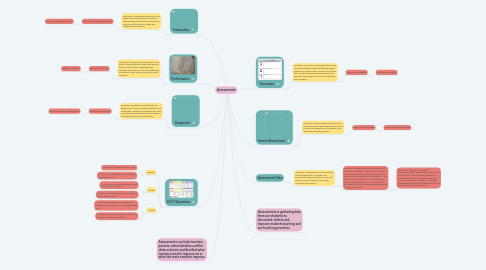
1. Formative
1.1. Definition: Formative assessments are a way to gather students learning while providing feedback to the learners. Teacher can look at the formative assessment and decide how they can adjust their instruction to better fit their students.
1.1.1. Example: Exit tickets
1.1.1.1. Example: Discussion
2. Interim/Benchmark
2.1. Definition: Interim assessments are done periodically throughout the year but don't provide any feedback for students. They are for the teacher records.
2.1.1. Example: Benchmarks
2.1.1.1. Example: Running Records
3. Summative
3.1. Definition: Summative assessments are taken after a large chunk of learning. Teacher need to teach test taking skills and review the question types the students will be seeing.
3.1.1. Example: Standardized Testing
3.1.1.1. Example: Research Projects
4. Performance
4.1. Definition: Performance assessments are a way to take information they have learned and transfer it into an engaging way. Students will usually do this by putting the information they learned into a real world situation.
4.1.1. Example: Portfolios
4.1.1.1. Example: Journals
5. Diagnostic
5.1. Definition: Diagnostic assessments are taken prior to assess students background knowledge, weakness, strengths and, skills. The teacher will then take this information and adjust instruction accordingly.
5.1.1. Example: Quickwrites
5.1.1.1. Example: Phonics Assessments
6. Assessment Data
6.1. Definition: Teachers can use assessment data to determine if students are successful with the content. If they are not successful, teachers can adjust instruction or reteach.
6.1.1. Struggling Students: AMC Math Data about ten frames: Student 1: level 1 on AMC test, he didn't pass the ten frame portion, adding 10 plus some more. Student 2: Passed level 1 for ten frames, but not level 2 for adding 9 plus some more. Student 3: level 1 on AMC test, she didn't pass the ten frame portion, adding 10 plus some more.
6.1.1.1. Strategies: Student 1- providing manipulatives (ten frames and counter tiles) and working in a small group. Student 2- providing extra time on assessments and one-on-one support. Student 3- breaking assessment up into smaller time periods and extra tutoring time during MAP.
7. H.O.T Questions
7.1. Opening
7.1.1. 1. Can you list three types of coins?
7.1.2. 2. Can you recall which coin has George Washington on it?
7.2. Guided
7.2.1. 1. What coins can you find that has the same value of a dime?
7.2.2. 2. What are the different parts of a penny? (Front, back, value)
7.3. Closing
7.3.1. 1. What could be done to minimize my 15 pennies? What coins could I exchange them for?
7.3.2. 2. How could you determine the difference between a nickel and a quarter?

